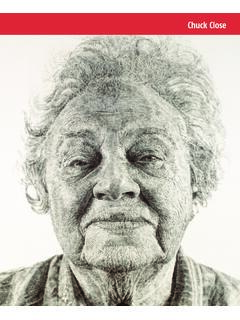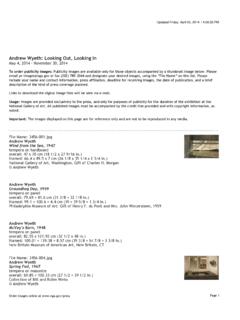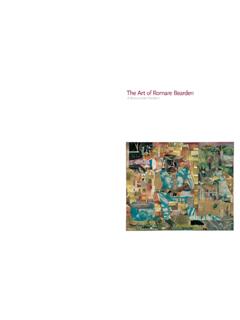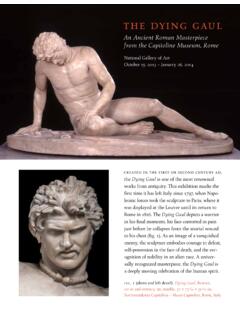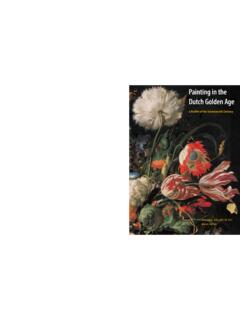Transcription of Degas’s Little Dancer - National Gallery of Art
1 Degas s Little Dancer National Gallery of Art October 5, 2014! !January 11, 2015 Fig. 1 Edgar Degas, The Dance Class (Ecole de Danse), c. 1873, oil on canvas. Trustees of the Corcoran Collection (William A. Clark Collection)Fig. 2 Edgar Degas, Dancers at the Old Opera House, c. 1877, pastel over monotype on laid paper. National Gallery of Art, Washington, Ailsa Mellon Bruce CollectionFig. 3 Edgar Degas, The Dance Lesson, c. 1879, oil on canvas. National Gallery of Art, Washington, Collection of Mr. and Mrs. Paul Mellon Little Dancer aged Fourteen (cover) holds a unique place in the work of Edgar Degas (1834! !1917). Among the more than one hundred sculp-tures he created in wax, clay, and other materials, it is the only one he ever chose to exhibit.
2 At least thirty bronze and two plaster versions of it were cast after his death, all of them based on Degas s original wax-and-clay sculpture! !the sole version he ever touched! !which is now at the National Gallery of Art. This exhibition places the statuette amid a select group of other works by Degas with ballet subjects from the Gallery s collections, as well as an oil painting (fig. 1) and a pastel drawing from the Corcoran Paris Opera Ballet fascinated Degas for more than forty years. Descended from an academy established in 1661 by King Louis "#$, it became a leading cultural institution of nineteenth-century France, its audiences packed with the elite of Parisian society. The Opera Ballet o%ered Degas a contemporary social setting full of brilliant color, elabo-rate sets, and beautiful costumes; above all it a%orded the opportunity to study the human figure in motion.
3 The movements of dancers! !mod-ern yet timeless! !seemed to him to preserve an ancient Greek ideal of beauty. Regularly attending performances, he also obtained access to the rehearsal rooms, the backstage, and the wings, spaces that would come to dominate his repertoire. Observation at rehearsals, classes, and perfor-mances (fig. 2) underlies his portrayals of dancers in a variety of media. He captured their discipline and elegance, but he was equally interested in their o%stage moments of rest or exhaustion (fig. 3). He studied dance movements and positions obsessively (fig. 4), kept a collection of props such as tutus and slippers, and regularly brought dancers into his studio to model for model for Little Dancer aged Fourteen, Marie Genevi ve van Goethem (June 7, 1865! ?), has been identified through an inscription on a preparatory drawing (fig.)
4 5). Born in Paris to a tailor and laundress from Belgium, she grew up in poor neighborhoods, as did many of the ballet students known as rats ! !slender creatures who scampered in from the alleys. The idea of a street-urchin Dancer fascinated Degas so much that Fig. 4 Edgar Degas, Dancer Seen from Behind and Three Studies of Feet, c. 1878, chalk and pastel on blue-gray paper. National Gallery of Art, Washington, Gift of Myron A. Hofer in memory of his mother, Mrs. Charles Hoferhe later wrote a sonnet about such a girl, wishing that she might achieve an illustrious life without losing a sense of the race of her street. Marie was dismissed from the ballet in the summer of 1882, probably after repeated missed rehearsals, and disappears from the records. By contrast, her younger sister Charlotte, who apparently also modeled for Degas, went on to a successful career as a ballerina and teacher.
5 Little Dancer , eyes half closed in concentration, represents a girl whose life may hang in the balance between ascent and downward devoted years of careful craftsmanship to preparing Little Dancer for exhibition; he had initially intended to have it ready for the fifth impressionist exhibition in 1880 but twice postponed displaying the statuette, finally installing it during the second half of the 1881 exhibition. Drawing the Dancer at least twenty-six times, from multiple points of view, he modeled her slender form over an armature of metal rods and wires (suggested by a scribble in the upper right of one of his studies, fig. 6, that matches the internal armature revealed in the x-radiograph, fig. 7). Bulk-ing out the figure with wood, rope, and padding, he coated this core with clay and finally with layers of translucent, pigmented wax.
6 The arms were formed separately, incorporating paint brushes to reinforce the wire sup-porting them (see diagram, fig. 8). He dressed her in a cotton and silk tutu and linen slippers, with a ribbon binding her wig of dark blond human hair. The result, as described by the critic Jules Claretie, was a strangely attractive, disturbing and unique Naturalism. 1 The smaller Study in the Nude of Little Dancer aged Fourteen (fig. 9) was once thought to be a preparatory stage for the dressed statuette. National Gallery of Art conservation research indicates instead that the Fig. 5 Edgar Degas, Four Studies of a Dancer , c. 1878! !1881, chalk and charcoal, heightened with gray wash and white, on bu% wove paper. Mus e du Louvre, Paris, D partment des Arts Graphiques, Fonds du Mus e d Orsay. Image: R union des Mus e Nationaux/Art Resource, NY (not in exhibition)1 Cited in Charles S.
7 Mo%ett, ed. The New Painting, Impressionism, 1874-1886, San Francisco: Fine Arts Museums of San Francisco, 1986; p. 6 Edgar Degas, Three Studies of a Nude Dancer , c. 1878, charcoal heightened with white chalk on gray wove paper. Private collec-tion (not in exhibition)Fig. 7 X-radiograph of Little Dancer aged Fourteen (overall, frontal view)Fig. 8 Schematic diagram of the internal armature of Little Dancer aged Fourteen. Illustra-tion by Julia Sybalsky and Abigail Mack, 2007nude figure was essentially cast in molds taken from an earlier, lost study in wax or clay, suggesting it is an independent variant of the Little Dancer aged Fourteen. Degas seems to have worked on both the full-sized version and the smaller surviving nude simultaneously, and may have continued to adjust the nude figure even after the dressed version was exhibited.
8 His change in the position of the right foot, for instance, left an impression still visible in the plaster today as an image of youthful promise, Little Dancer sparked controversy when it appeared in 1881. Sculptures sent to exhibitions were traditionally made of marble, bronze, terracotta, or plaster. For his statuette, Degas picked materials associated with both religious images of the past (lifelike painted and clothed statues of saints) and anthropologi-cal displays in museums, where realistic, dressed wax figures were shown in glass cases! !as Degas exhibited Little Dancer in 1881. Critics responded with excitement to Degas s sculpture, calling the Dancer a Little flower of the gutter, with the instinctive ugliness of a face on which all the vices imprint their detestable promises. But a sympathetic observer, novel-ist Joris-Karl Huysmans, wrote: The terrible realism of this statuette makes the public distinctly uneasy, all its ideas about sculpture, about cold lifeless whiteness.
9 !.!. are demolished .!.!.! this statuette is the only truly modern attempt I know in sculpture. 2 Indeed, conventional female subjects for sculpture included ancient goddesses, allegorical figures, or heroines from literature. Degas took an artistic risk in modeling! !and clothing! !a wax figure of a contemporary girl, in training for a profession with a dubious reputation in his time. Like performance and sports today, a dance career o%ered a slim chance at stardom and escape from poverty, but it also brought temptations and risks. Most dancers made very Little money and often looked elsewhere for support. An occasional ominous presence in Degas s ballet pictures is the Fig. 9 Edgar Degas, Study in the Nude of Little Dancer aged Fourteen (Nude Little Dancer ), c. 1878! !1881, pigmented bees-wax, plaster core, metal and wood armatures, on plaster and wooden bases.
10 National Gallery of Art, Washington, Collection of Mr. and Mrs. Paul Mellon2 Mo%ett, pp. 341, gentleman, gazing from a theater box or side wing or standing backstage (figs. 2, 10). Such figures were wealthy ballet subscribers who were granted access to behind-the-scenes spaces at the opera house! ! and hence to dancers, often becoming their protectors, a subject of salacious gossip. The experimentation Degas brought to the creation of Little Dancer , combining materials in inventive ways, is typical of his approach to making art regardless of medium. Dance also provided the subject for The Ballet Master, his first monotype (fig. 11), a kind of print for which he manipulated ink on a blank copper plate with brush, fingers, or cloth. Sending it through a press with a sheet of paper produced a single, lush impression, and sometimes a second fainter one.

